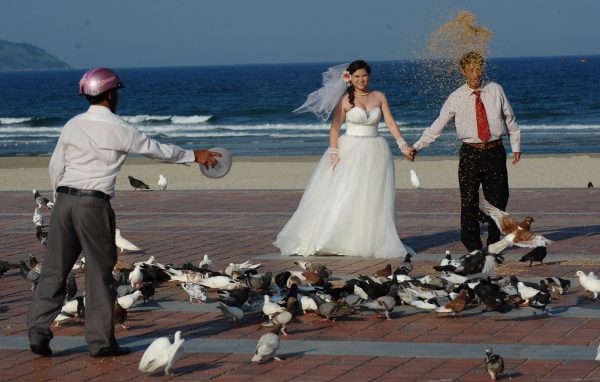In the case of Taiwan, marriages to a foreign-born wife accounted for 13 per cent of all new marriages in 2009, down from a high of 28 per cent in 2003. Does cross-border marriage represent citizens exercising a fundamental right recognised in the Universal Declaration of Human Rights? Or, since many of these marriages involve forms of brokering, are they as many critics contend a form of human trafficking?
Marriages between women from less wealthy regions to men of affluent nations emerged as an aspect of the significant growth in global migration since the 1970s, with possibilities for mass travel on wide-bodied jets and the associated phenomenon of global mass tourism.
The first ‘wave’ to catch public attention was Filipinas seeking spouses in countries like the United States, Canada and Australia. Relatively high levels of education and ability to speak English enabled these women to engage in correspondence courtship, brokered through third parties such as agents (often also travel agents) or magazines — in the case of Australia, Australian Post and Australian Singles.
This is the origin of the pejorative term ‘mail order bride’, which denied the agency of the women and disregarded the ways in which the couples negotiated relationships through mail, phone calls and face-to-face meetings. When I interviewed transnational couples who had experienced correspondence courtship (including via the internet) their narratives commonly fixed on the moment when ‘the spark’ between them was ignited: ‘And the rest is history’ was a common phrase used.
The Australian experience gives us an important clue to how this phenomenon has further developed in East Asia. Many of the Filipinas who married Australians were urban educated women who married men in mining towns in places such as Western Queensland or the Hunter Valley. Earlier waves of Australian migration that attracted male industrial workers resulted in localised demographic imbalances. Correspondence courtship to seek a Filipina spouse was one of the few avenues open to these male migrants to marry and have a family life.
Another early global trend involved women from Thailand and the Philippines marrying Japanese men. Some of these were ‘entertainment marriages’ with women migrants in the entertainment industry, but many brokered marriages echoed the Australian pattern, with farmers seeking a solution to their difficulties finding Japanese spouses.
Demographic imbalances have contributed to the rise of cross-border marriages (in the case of South Korea and Taiwan, as a consequence of sex selective abortions), as has increasing education levels creating new aspirations for women in East Asia whereby life as a farmers’ wife does not appeal. In urbanised Singapore, women want to ‘marry up’ (encouraged by state-sponsored population control policies) so low-status men in low-paid jobs face difficulties marrying. They — or their parents — broker marriages with women from Vietnam and Thailand.
Is this a form of trafficking? Brokering cross-border marriages has become a business opportunity for companies that are often also employment or travel agents. Men can pay up to US$10,000 to brokers, who might net US$1000–$5000 per ‘transaction’. But a significant proportion are still arranged by relatives. Often, the arranging of these transnational marriages is akin to customary forms of marriage brokerage.
South Korea has very high rates of cross-border marriage. Vietnamese, (including ethnic Chinese) mainly from the poorer south, are becoming the most common marriage migrants to East Asia. China, Cambodia and Mongolia are also becoming sources of brides.
Cases of abuse, such as Southeast Asian women unwittingly being recruited to prostitution by Western or East Asian spouses through promises of marriage, or cases of family violence, attract sensational reporting. While these illegal actions require official responses and management they should not be used to argue for bans on cross-border marriage.
Australia and the Philippines, for example, have long implemented policies aimed at minimising the risk of exploitation of prospective brides — and grooms. These included improved processes for testing the authenticity of relationships but also working with community and church organisations to provide information to prospective marriage migrants about life in Australia and their legal rights and support services. South Korea, for example, has followed a similar path with screening and counselling of foreign brides and spouses. There are also many NGOs providing support to migrant brides.
The governments of countries from which cross-border spouses come have struggled to regulate the phenomenon, oscillating between attempts to ban and regulate brokers. But banning is difficult. Brokering is an outgrowth of customary forms of arranging marriage, and it relies very heavily on personalised networks. It is still the case that the majority of cross-border marriages are organised through family and kinship networks, and increasingly facilitated by modern technology. These marriages can be particularly important in allowing women from less-developed countries to work in high-wage economies and send home remittances.
Cross-border marriage is inevitable in our globalised world, an aspect of its cosmopolitanism. It inevitably involves risk, but for many it offers opportunities in regard to their personal life, social experience as well as economic opportunity.
Kathryn Robinson is a professor of anthropology at The Australian National University.


Some of these marriages are like mine: I went to work in Japan in 1969, met and married my Japanese wife in 1971, and brought her back to live with me. No brokers, etc were involved. Fortunately, our respective families accepted our marriage and have supported us over these wonderful 44 years.